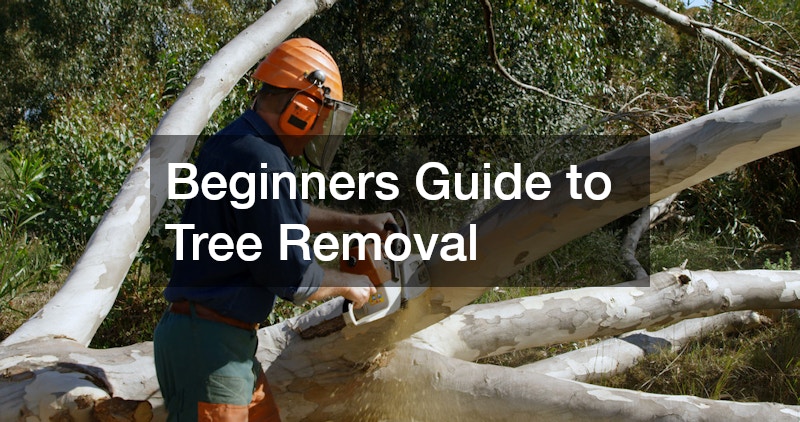Tree removal can be a daunting task for beginners who are unfamiliar with the process. This guide aims to provide you with the fundamental knowledge and steps to safely and effectively remove unwanted trees from your property. By understanding the reasons for tree removal, the safe methods to carry it out with your local tree service, and the legal implications, you will be well-equipped to undertake this task responsibly.
When is Tree Removal Necessary?
1.1 Assessing Tree Health
Learning to assess tree health is crucial for determining whether removal is necessary. Trees that are diseased, dead, or dying can pose significant risks to property and safety, making their removal important. Regularly inspect trees for signs of disease, such as discolored leaves, unusual growths, or wilting branches.
It is essential to act swiftly if a tree shows symptoms of poor health to prevent hazards. Sometimes, the problem may be reversible with proper care, but when a tree poses a danger, removal becomes a prudent choice. Consulting an arborist can offer clarity on a tree’s health and its potential need for removal.
In some instances, a tree may look healthy externally but suffer internally. Diseases like heart rot can severely compromise a tree’s structural integrity over time. Understanding and detecting such issues can help property owners make informed decisions about tree removal.
1.2 Identifying Hazardous Trees
Trees that pose a safety risk often show signs of structural weakness or instability. Branches that overhang roofs, power lines, or sidewalks can be particularly dangerous. It is important to recognize these hazards promptly to avoid potential accidents or property damage.
Sometimes, trees can be destabilized by environmental factors, such as soil erosion or strong winds, increasing the risk they pose. Look for leaning trees, cracked trunks, or exposed roots as telltale signs of instability. Swift action can prevent unexpected failures that might result in greater costs or injuries.
Hazardous trees are not just a threat to safety but also interfere with utility lines and structures. It’s crucial to notify utility companies if trees come into contact with power lines. Professionals can help determine if pruning is adequate or if removal is necessary.
1.3 Considering Property Development
Tree removal can be an essential step in property development projects. Whether expanding your home, creating a new landscape design, or constructing additional structures, trees might need to be cleared. It’s vital to consider the long-term implications of tree removal on your project’s success and the environment.
Removing trees can also help ensure adequate sunlight and prevent root interference with new building foundations. While removing trees might clear space, it is important to plan for potential problems, such as soil erosion and loss of shade. Mitigating these effects requires careful consideration and planning, often involving landscaping alternatives.
Always weigh the ecological costs against the benefits of removing trees for property development. Consider preserving any trees that don’t interfere with your plans, as mature trees have environmental and aesthetic value. When trees must be removed, incorporate plans for replanting to maintain the ecological balance.
How to Safely Remove a Tree
2.1 Gathering the Right Tools and Equipment
Using the correct tools and equipment is paramount in ensuring a safe tree removal process. Essential tools include chainsaws, protective gear like helmets and gloves, and harness equipment for climbing. Familiarize yourself with these tools before starting, as proper handling minimizes mishaps.
Each tool has a specific role in tree removal, impacting the efficiency and safety of the operation. Chainsaw maintenance is critical to ensure smooth cutting and reduce the risk of accidents. Safety gear such as eye protection and earplugs shields you from debris and noise pollution.
Having a comprehensive toolkit ready allows you to tackle varying challenges during tree removal. Besides cutting tools, using ropes and wedges can help guide the tree’s fall direction. By preparing thoroughly, you can manage the process smoothly and reduce hazards associated with tree removal.
2.2 Understanding the Tree Removal Process
Understanding the tree removal process is critical to executing the task safely and effectively. Begin with a detailed site assessment to identify potential hazards and plan accordingly. Establishing a clear fall path and ensuring the area is secure is crucial to preventing accidents.
Trimming branches prior to cutting the trunk can reduce weight and assist in directing the fall. The cutting process should involve strategic notching to guide the direction of the tree’s fall. Patience and precision during each step can make the difference between a successful removal and a mishap.
Post-cutting, use proper disposal methods for the tree and debris. Consider recycling or repurposing wood for firewood or mulch. Never leave stumps unattended as they can pose safety risks and might encourage pest infestations.
2.3 Hiring Professional Tree Removal Services
While DIY tree removal is an option, hiring professionals can be beneficial for various reasons. Professional services bring expertise, minimizing risks, particularly for large or hazardous tree removals. Their experience in handling complex situations ensures the job is completed efficiently and safely.
Cost considerations are crucial when deciding between DIY and professional services. While hiring contractors might be more costly upfront, it can prevent potential injuries and property damage that result from amateur work. Additionally, they often have licenses and insurance coverage, adding a layer of security for homeowners.
Professional tree removal also allows you to focus on other property developments while they do the heavy lifting. Time saved can be invested in planning your next steps, such as landscaping or construction. Researching and hiring reputable services ensures peace of mind and a successful outcome.
Tree removal is an important task that requires careful consideration and planning. With the right knowledge and resources, beginners can safely manage tree removal processes, whether by themselves or with professional help, while keeping legal and environmental factors in mind. Being mindful of health assessments, safety protocols, legal requirements, and environmental impacts ensures responsible tree management for the benefit of people and nature alike.
.



